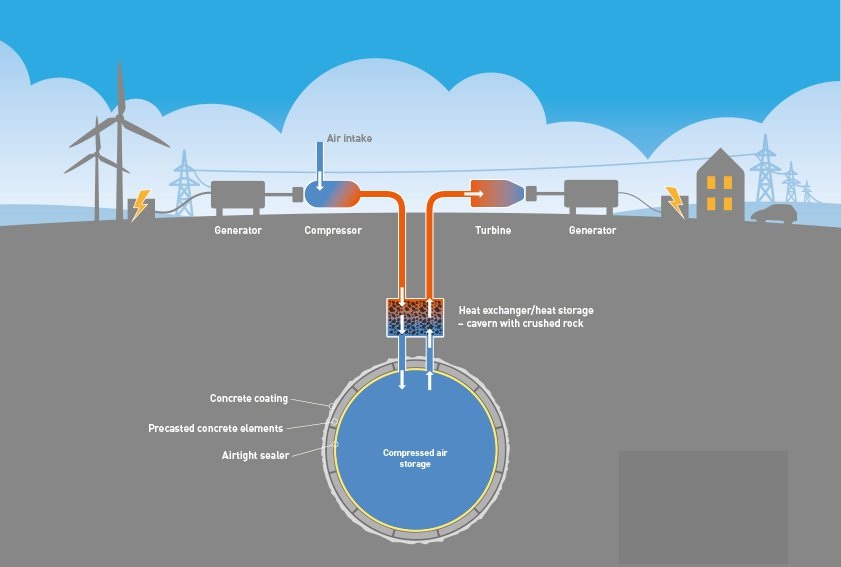Air could be the World's Next Battery
Summary
Wind and Sun, both are unpredictable resources that are becoming ever more significant sources of energy in Europe these days. This means that we face an emergent need for energy storage amenities, because if energy cannot be used immediately when it is generated, then it needs to be stored until it is needed or used.
While the idea first came out by some of the European researchers through a research project - RICAS stating by 2020 they will be helping to realize the surplus energy that is generated by wind turbines and solar cells is used to compress air. However, it is stored in caverns in solid bedrock. Do you know that when the air is compressed, it heats up, and a separate underground heat stores the stockpiles and then the heat is generated by the compression process. But, when we need energy; then the air will be released through a gas turbine, which then generates the electricity. The more hot air that is released throughout the heat store on its way out. In this process the more electricity will be generated; in other words, it can also be more effective when this generated energy is stored properly in the storage.
Introduction
Let's look at the better methods to generate the energy. The least expensive method to use is hydropower reservoirs as 'batteries', as this is the way we can generate electricity using the stored water. This method helps when power is in short supply, and subsequently, we can pump the water back uphill when surplus renewable energy is accessible. However, this is a good practical method which can be used only in the mountainous regions.
But what if less fortunate countries and regions could use air as an alternative to water as in to store the energy? Under the sponsorship of the European Union, the scientists from all over the Europe are attempting to turn on this concept into a feasible prospect, through a research project called RICAS 2020; of which SINTEF is a member. The participants of this project have in mind that all parts of the world where sealed abandoned caverns could be used as storage sites.
In Detailed - like a hot bicycle- tyre pump
The general principle, which has already been adopted at some sites around the world, is of using the surplus electric power to compress the air, and which is then stored in an underground cavern. while when the power needs to be made available, the air is then released through a gas turbine that generates electricity. However, the existing plants of this type are frequently used to meet the peak demands of a supplement to classical power plants, providing the right amount of electricity when it is needed at different times during the day.
However, the physics governing the storage of the energy in the form of compressed air is a result of a law of nature which is familiar to every user of a bicycle pump: it is the process of compressing air heats it up. We know how bicycle pumps compress air in order to boost the pressure of the tyres, and in doing so, it makes the pump hot.
while when the more heat of compression that the air has retained when it is unrestricted from the store, the more work it can complete as it passes through the gas turbine. And we think that we will be able to preserve more of that heat than current storage technology can, therefore it increases the net efficiency of the storage facilities.
How to underground cavern as heat storage
Do you know that we have two largest compressed air storages in the World? One is Germany and the other in the USA. both the storages are underground chambers formed in salt formations. But these storage plants lose a large amount of the potential energy of the compressed air, as they do not incorporate a system to storing the heat produced during the air compression stage.
To find a solution and help the storage companies in not losing the potential energy the participants in RICAS 2020 have a came up with a recipe for reducing these losses in future underground storage caverns. At the core of the recipe is an extra position that they have included in their solution.
- On its way down to the underground cavern, the hot compressed air should pass through a separate cavern filled with crushed rock.
- The hot air then heats up the rock, which will in return retain a large proportion of the heat.
- Then the cold can be stored in the main cavern
- which will help the air to subsequently return to the crushed rock on its way to being used to generate electricity, this flow of air is reheated by the stones
- lastly, the hot air is then expanded through the turbine generating the electricity
How it is cheaper than batteries
The SINTEF's process manager says that it is estimated that this technology could raise the competence of the system to as much as 70-85%. While the corresponding figures for most of the existing storage sites are no enhanced than 45-55%, which means that the produced energy is only partially of what was at first used to condense the air into a cavern.
While this project is based on the belief and a solution which is offered to produce better energy storage than batteries can ever provide. Thanks to its longer lifetime and lower capital cost per kWh of stored energy. In future, the experts say that we can also expect that it can be employed practically irrespective of the type of geological formation accessible.
Neglected caverns would be just the thing
As per the expert's words - there is only a single requirement as regards the choice of site. While the large hollow spaces must exist, as they would be too expensive to excavate new caverns and making them safe is again be a challenge.
The participants of the project are therefore envisaging that existing abandoned or neglected underground caverns and spaces could be reopened to house the compressed air.
Casing to seal the cavern walls? what is this
While the SINTEF researcher who is a materials scientist says that in this European project he is responsible for SINTEF's investigate and develop the efforts for chasing to seal the cavern walls which will be needed to keep the compressed air storage sites accurately airtight.
There are many SINTEF scientists who are struggling to contribute their expertise in underground technology, with the calculations that will guarantee that their solutions, including the sealant materials, will be competent of withstanding the pressure they will be exposed to. However, this project will lead to a set of technical specifications and detailed cost analyses.
Believes hot energy storage could lead to a breakthrough - Professor Finkenrath
The compressed air stores of the sort that this project is aiming for, this could provide significantly lower costs and greatly improve the storage capacity compared to batteries. If this project leads to storage plants being established under a wide range of geological conditions, then it can be in itself an important step which goes forward.
But, If the project partners are also winning with their plans for well-organized heat storage, the use of compressed air for energy storage could be on the edge of a breakthrough.






